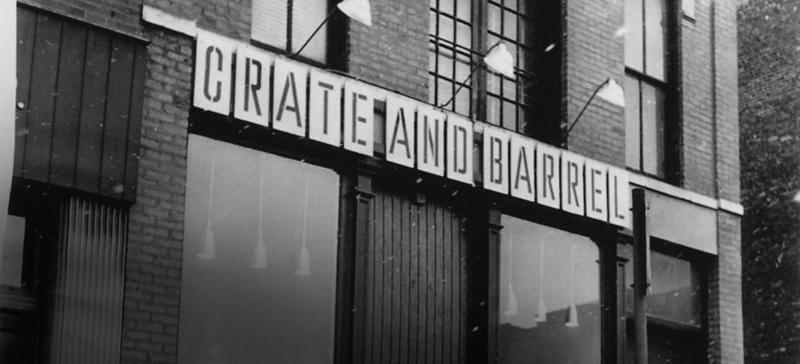The Origin of Crate and Barrel: A Northwestern Romance and Legacy
Gordon and Carole Segal founded Crate & Barrel in 1962, driven by their passion for European design. Their legacy extends to a $10M gift to Northwestern University, where they met, showcasing their lasting impact on retail, education, and community.

Crate and Barrel is a name synonymous with modern, functional home furnishings and décor. With a distinctive blend of affordability, European-inspired design, and quality craftsmanship, it has become a household name. This blog explores the story of Crate and Barrel’s origin, tracing its journey from a modest store in Chicago to a leading global home retailer.

1. Founding Story
Gordon and Carole Segal met while studying at Northwestern University, where Gordon earned a bachelor’s degree in business, and Carole graduated with a degree in English in 1960. Inspired by their European honeymoon, where they were captivated by the simplicity and style of home goods unavailable in the U.S., the couple co-founded Crate & Barrel in 1962. Their first store was in a former elevator factory in Chicago’s Old Town, with the startup capital coming from their personal savings.
Due to limited resources, the Segals displayed merchandise on the very crates and barrels used for shipping, a creative solution that lent the store its unique name and branding. The couple’s entrepreneurial spirit and innovative display methods resonated with customers, establishing Crate & Barrel as a fresh, modern alternative to conventional houseware stores.
2. Early Growth and Challenges
Crate & Barrel’s initial years were defined by determination and adaptability. The Segals faced significant challenges in sourcing quality European products and navigating a tight budget, but their passion for high-quality, affordable housewares drove them forward. The brand’s focus on European design and customer-centric service set it apart and helped foster early growth.
Expansion was gradual at first, but by the 1970s, Crate & Barrel’s reputation was spreading. The company began adding more stores across the U.S., capturing customers’ attention with its unique displays and carefully curated products. The use of visually appealing catalogs showcasing styled products further fueled their growth.
3. From Housewares to Home Furnishings
Originally specializing in housewares such as glassware and kitchen items, Crate & Barrel expanded its product line to include furniture and broader home décor. This transition solidified its position as a one-stop shop for home needs and allowed the brand to compete on a larger scale.
As demand grew, the company embraced the digital age with early adoption of online sales and a robust e-commerce presence. This helped Crate & Barrel maintain its relevance and appeal to new generations of shoppers.
4. Collaborations and Exclusive Designs
Crate and Barrel distinguished itself through partnerships and collaborations with well-known designers and exclusive product lines. These collaborations brought unique styles and limited-edition pieces that kept the brand’s offerings fresh and desirable. By working with artists and artisans, Crate and Barrel continued to innovate while staying true to its core value of affordable elegance.
5. Expansion to International Markets
As Crate and Barrel’s popularity surged, the brand set its sights beyond the U.S. It opened its first international store in Toronto, Canada, and continued to expand into other markets, including Europe and Asia. Adapting to international tastes while maintaining the brand’s essence proved to be a successful strategy, allowing Crate and Barrel to compete on the global stage.
The brand’s flagship stores, such as the one in New York City, showcase the full range of Crate and Barrel products and highlight the brand’s commitment to design excellence and customer experience.

6. CB2: A Contemporary Expansion
To appeal to a younger, urban audience, Crate & Barrel launched CB2 in 2000. This new brand focused on bold, minimalist designs that fit smaller spaces and modern tastes. CB2 maintained Crate & Barrel’s commitment to quality while introducing trendsetting collaborations and unique design partnerships. This move helped diversify the company’s offerings and reach a broader customer base, blending contemporary style with the legacy of Crate & Barrel.

7. Ownership Changes and the Segal’s Legacy
Gordon Segal led Crate & Barrel until his retirement as CEO in 2008, after which he continued to contribute to Northwestern University as a Board of Trustees member. Carole Segal also made significant contributions to the university, co-founding Foodstuffs Inc., serving on the Board of Visitors of Weinberg College of Arts and Sciences, and acting as president of the Northwestern Women’s Board. Their joint commitment to education is highlighted by their $10 million gift, which supported several departments and initiatives at Northwestern, leading to the naming of the Segal Visitors Center.
The Segals’ dedication extended beyond financial contributions. Gordon played a pivotal role as chair of the Educational Properties Committee, guiding the development of key facilities such as the Music and Communication Building, Kellogg’s new global hub, and the Biomedical Research Building. Their philanthropy also includes the Segal Design Institute, established in 2007 through a substantial gift to foster interdisciplinary learning at Northwestern’s McCormick School of Engineering and Kellogg School of Management.
The couple’s philanthropic and entrepreneurial legacy demonstrates their belief in nurturing innovation and education. Their continuous support since 1986 underscores their dedication to making a meaningful impact on future generations, both in the retail industry and academic world.

8. Crate and Barrel Today
Today, Crate and Barrel stands as a leader in home furnishings, known for blending modern style with practical design. Its product range includes everything from sleek furniture to artisan-crafted décor and home essentials. The company continues to innovate with a strong online presence and strategic store expansions.
Recent Trends:
- Expanded partnerships with designers and artisans.
- Investments in technology for a seamless shopping experience.
- New initiatives focusing on sustainable sourcing and eco-friendly products.
Conclusion
From its modest beginnings in an old factory using crates and barrels as displays to an influential global brand, Crate & Barrel’s story is one of vision, hard work, and adaptation. The creation of CB2 added a contemporary twist, proving that innovation and expansion can coexist with a dedication to original values. Gordon and Carole Segal’s journey and contributions to both the retail world and their alma mater, Northwestern University, exemplify the impact of a strong vision and unwavering commitment to excellence.
Ensure you’re getting the best value on Crate & Barrel’s stylish furnishings by using Spoken. With price comparisons and deal tracking across top retailers, Spoken helps you shop smarter and save more on your favorite home décor items.
Quick facts
Who founded Crate & Barrel?
Crate & Barrel was founded by Gordon and Carole Segal in 1962. Inspired by their European honeymoon and the desire for stylish, affordable home goods, they opened the first store in Chicago's Old Town, displaying products on crates and barrels, which inspired the store's name.
Why is Crate & Barrel called that?
The name 'Crate & Barrel' comes from the store’s original displays. The founders, Gordon and Carole Segal, used the very crates and barrels in which products were shipped to display their merchandise in their first store, creating a unique and memorable brand identity.
What made Crate & Barrel popular?
Crate & Barrel became popular due to its European-inspired design, affordable yet high-quality products, and unique in-store displays. The brand also set itself apart by focusing on customer-centric service and expanding its offerings to include furniture and home décor.
What is CB2, and how is it related to Crate & Barrel?
CB2 is a contemporary offshoot of Crate & Barrel, launched in 2000 to target a younger, urban audience. It focuses on bold, minimalist designs for modern living spaces while maintaining Crate & Barrel’s commitment to quality and innovative collaborations.
What were some challenges Crate & Barrel faced in its early years?
Crate & Barrel faced challenges such as sourcing quality European products and operating on a limited budget. However, their creative displays and focus on customer service helped overcome these obstacles and establish the brand as a fresh alternative to conventional houseware stores.
Where did Crate & Barrel open its first international store?
Crate & Barrel opened its first international store in Toronto, Canada. This move was part of their expansion strategy that later included stores in other countries, adapting to international tastes while maintaining the brand’s core design principles.
What role did catalogs play in Crate & Barrel's growth?
Crate & Barrel used visually appealing catalogs to showcase styled products, which contributed significantly to their growth. These catalogs helped customers visualize products in home settings, enhancing the brand's appeal and reach across the U.S.
How did Crate & Barrel embrace technology in its expansion?
Crate & Barrel was an early adopter of online sales, establishing a strong e-commerce presence. This move helped the brand stay relevant and attract new generations of shoppers, ensuring continued growth and innovation.
What philanthropic efforts are associated with the founders of Crate & Barrel?
Founders Gordon and Carole Segal made significant contributions to Northwestern University, including a $10 million gift supporting various departments. They also established the Segal Design Institute to promote interdisciplinary learning, showcasing their commitment to education and innovation.
What recent trends has Crate & Barrel focused on?
Recent trends for Crate & Barrel include expanded collaborations with designers, investments in technology for a seamless shopping experience, and initiatives focusing on sustainable sourcing and eco-friendly products to align with modern consumer values.
Is CB2 different than Crate and Barrel?
Yes, CB2 is a sub-brand of Crate & Barrel launched in 2000. It caters to a younger, urban audience with bold and modern designs, while Crate & Barrel offers more classic, European-inspired home furnishings.
What is the sister company to Crate and Barrel?
CB2 is the sister company to Crate & Barrel. It was launched in 2000 to appeal to a younger, urban demographic with modern and minimalist designs, while maintaining the quality associated with the Crate & Barrel brand.
Are Crate and Barrel and Pottery Barn the same?
No, Crate & Barrel and Pottery Barn are not the same. They are both well-known home furnishing retailers, but they are owned by different parent companies and have distinct styles. Pottery Barn is owned by Williams-Sonoma, while Crate & Barrel operates independently.
How ethical are Crate and Barrel?
Crate & Barrel has made strides in sustainability by focusing on eco-friendly sourcing and products. The brand’s ethical practices include collaborations with artisans and sustainable initiatives. However, consumers should research specific product lines and practices for a comprehensive understanding.
What is Crate and Barrel famous for?
Crate & Barrel is famous for its modern, European-inspired home furnishings and décor. The brand is known for combining quality craftsmanship with affordable elegance, making it a popular choice for stylish yet functional home goods.
What company owns Crate and Barrel?
Crate & Barrel is owned by the Otto Group, a German retail and services group. The acquisition allowed Crate & Barrel to expand its operations while maintaining its commitment to quality and design innovation.

Geoff Abraham
Co-founder & President of Spoken
Geoff is the co-founder and President of Spoken. He is a Dad. He holds a BA from UT Austin (Plan II) and an MBA from Stanford. Geoff has built several successful businesses, including a bicycle taxi business in San Francisco which he ran for 10 years with his wife, Mimosa. He is an executive coach, and he actively invests in seed-stage startups via The Explorer Fund.
Read more